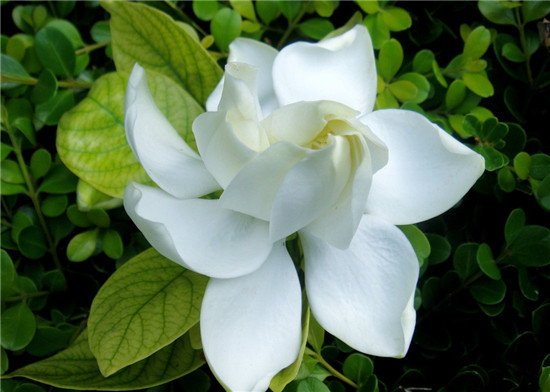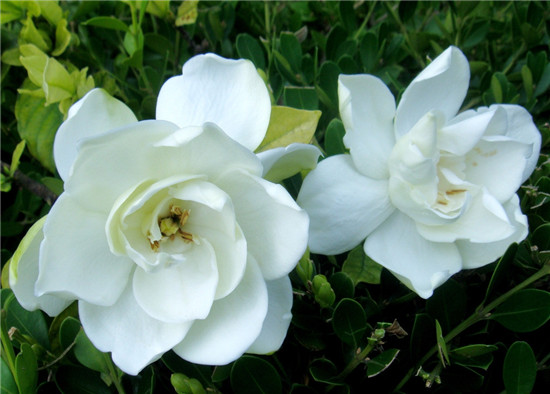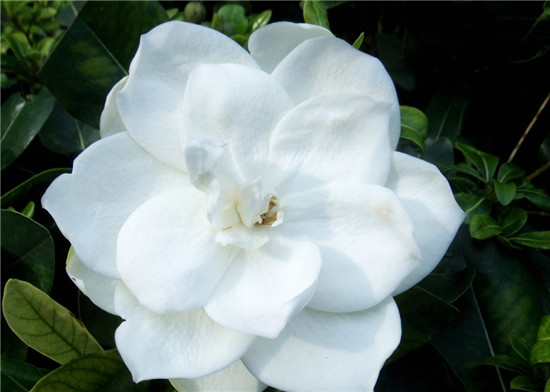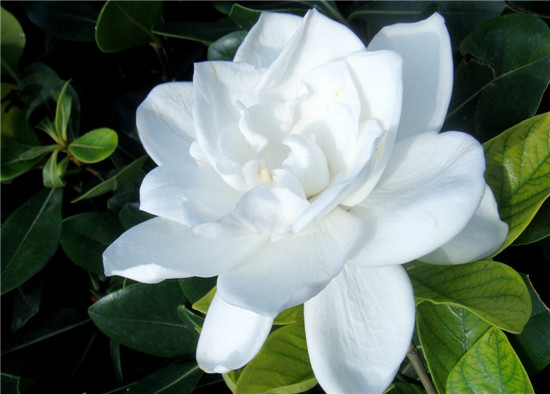[gardenia leaves yellowing] what if the leaves of Gardenia jasminoides turn yellow?
Gardenia is not only a good helper to improve the home environment, but also an expert in improving community air quality, so do you know how to grow this plant? Next, let's go and have a look.

With the use of more and more people's bedroom space, I believe many people pay more attention to some problems such as whether gardenia is poisonous. In fact, gardenia is non-toxic and has a strong fragrance, which can be used as a wearable flower. Flowers, fruits, leaves and roots can all have the effects of purging fire and removing annoyance, clearing heat and diuresis, cooling blood and detoxification. So many advantages its flower language is also very good, "eternal love, life waiting and joy".
For the problem of gardenia leaves yellowing, as long as it is not difficult to find the reason to solve it, there are many reasons for gardenia leaves yellowing under the cultivation of indoor space. the common reason for the yellowing of gardenia leaves is caused by the "lack of green disease" caused by physiological diseases.
Why the leaves of gardenia turn yellow? On the one hand, when it blossoms and pulls out new branches in early summer, it is normal for a small number of old leaves to turn yellow and take off (replacement of new and old) pay attention to supplement phosphorus and potassium fertilizer. On the other hand, there are many small holes in the leaves, so abnormal ones should pay attention to the prevention and control of red and yellow spiders, aphids and phosphoptera larvae; red and yellow spiders are mainly distributed on the opposite side of older leaves, such as needle size, red or yellow visible to the naked eye carefully. Medication: propargite Aphids are mainly harmful to new leaves, with a slightly larger shape than the tip of a needle, with various colors such as gray, dark green, gray and black, and the use of drugs: imidacloprid (internal absorption pesticide, can prevent a variety of pests), etc.; phosphoptera larvae, which often occur on large mast branches in 567 months, are shaped like silkworms, and the larval stage is smaller (about 3 mm) and gradually grows, and the leaves can be bitten into larger holes or gaps. Medication: dichlorvos, trichlorfon, etc.

How to do gardenia leaves yellowing? Gardenia is sexually fond of the sun, but it is not suitable to accept direct sunlight, so when planting on the ground, you should have a shady environment for big trees to cover the shade. Potted gardenias should be kept in a shady place, and should not be placed tightly on the balcony and basking in the sun, otherwise gardenias will be vulnerable to burns that cause yellow and scorched leaves.
There are many reasons for the yellowing of the leaves of Gardenia jasminoides, which is rarely caused by chlorosis caused by physiological diseases. Whether potted or cultivated in the ground, if the soil is alkaline or iron deficient, it is more common. Iron deficiency is expressed as loss of green and yellowing between the veins of young leaves, seriously yellowing the whole leaves, and even scorched leaves and branches withering, resulting in plant death. Therefore, gardenia planted in the ground had better choose well drained, loose and fertile acid soil; potted plants should use 2 parts of rotten soil and 1 part of garden soil, and it would be better to add some mud mixture. Yellow leaf disease occurs during the growth period from May to September. 0.1% ferrous sulfate or 0.5% sulfate hinge can be added to the fertilizer solution and applied 12 times a month.
Curing methods of Gardenia jasminoides
1. Sexual reproduction: generally choose mature fruits that are full and crimson in color, bask in the shell or dry them. Before sowing, cut the pericarp of the seeds with scissors, dig out the seeds, rub them out in hot water, remove floating seeds or impurities, and then fish out the sunken full seeds.

2, asexual reproduction: cuttings can be divided into spring and autumn, cuttings choose healthy 2-3-year-old branches, cut 10-12 cm, cut off the lower leaves, the top two leaves can be retained and cut off half, first dipped in the vitamin B12 injection, and then obliquely inserted in the bed, leaving only one section above, pay attention to shade and maintain a certain humidity, transplant or plant on a pot when rooting seedlings begin to grow.
3. Give it an acidic environment. The content of soil, water and fertilizer all made the plant unable to absorb iron, but affected the formation of chlorophyll, withered branches, scorched leaves, and even died. To use fertile, loose, well-drained acid soil, such as pine sawdust thoroughly mixed into the soil, the use effect is also very good.
4. Control the amount of light. Its temperament likes shade, avoid scorching sun exposure, but often some people mistakenly think that gardenia requires full shade, resulting in mistakes in cultivation. In fact, while paying attention to cultivating its shady environment, it is necessary to maintain 60% light throughout the day in order to meet its growth needs.

5, chlorosis: the occurrence is more common, caused by a variety of reasons, so it is necessary to take different measures for prevention and treatment, generally apply rotten human feces and urine or cake fertilizer. When the young leaves are deficient in iron, the veins of the young leaves lose green and yellowing, which will seriously yellowed the whole leaves, and even scorched leaves and branches wither, resulting in plant death. To this kind of situation, can spray 0.2% Mel 0.5% ferrous sulfate solution to prevent and cure.
6. Soot disease: it occurs in branches and leaves. After it is found, it can be scrubbed with clean water, or sprayed with 0.3 Baumetu stone sulfur mixture, 1000-1200 times carbendazim.
7, rot disease: often occurs in the lower trunk, stem expansion, cracking, found immediately scraped or coated with 5-10 degrees of stone sulfur mixture, several times can be effective.
The above is the whole content of the yellow leaves of gardenia jasminoides for you. I hope this article can help you. Please continue to follow us.
Caused by a variety of reasons, it is necessary to take different measures for prevention and control, generally apply rotten human feces and urine or cake fertilizer. When the young leaves are deficient in iron, the veins of the young leaves lose green and yellowing, which will seriously yellowed the whole leaves, and even scorched leaves and branches wither, resulting in plant death. To this kind of situation, can spray 0.2% Mel 0.5% ferrous sulfate solution to prevent and cure.
6. Soot disease: it occurs in branches and leaves. After it is found, it can be scrubbed with clean water, or sprayed with 0.3 Baumetu stone sulfur mixture, 1000-1200 times carbendazim.
7, rot disease: often occurs in the lower trunk, stem expansion, cracking, found immediately scraped or coated with 5-10 degrees of stone sulfur mixture, several times can be effective.
The above is the whole content of the yellow leaves of gardenia jasminoides for you. I hope this article can help you. Please continue to follow us.
Related
- Wuhan Hospital Iron Tree Blooming Result Was Instantly Frightened by the Gardener Master
- Which variety of camellia is the most fragrant and best? Which one do you like best?
- What is the small blue coat, the breeding methods and matters needing attention of the succulent plant
- Dormancy time and maintenance management of succulent plants during dormancy
- Minas succulent how to raise, Minas succulent plant pictures
- What are the varieties of winter succulent plants
- How to raise succulent plants in twelve rolls? let's take a look at some experience of breeding twelve rolls.
- Attention should be paid to water control for succulent plants during dormant period (winter and summer)
- Watering experience of twelve rolls of succulent plants
- Techniques for fertilizing succulent plants. An article will let you know how to fertilize succulent plants.



